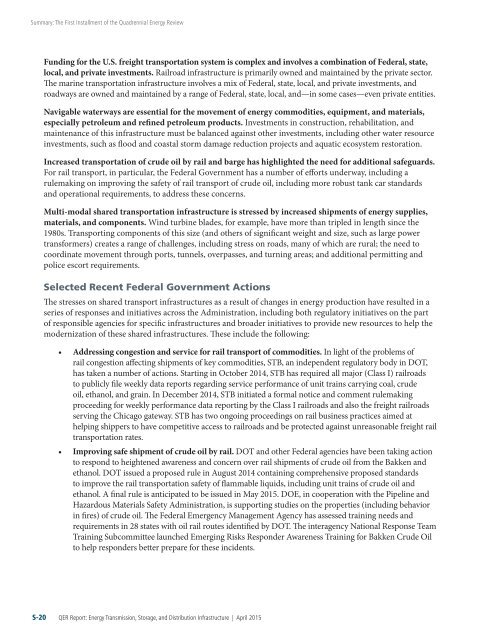LVXXU
LVXXU
LVXXU
You also want an ePaper? Increase the reach of your titles
YUMPU automatically turns print PDFs into web optimized ePapers that Google loves.
Summary: The First Installment of the Quadrennial Energy Review<br />
Funding for the U.S. freight transportation system is complex and involves a combination of Federal, state,<br />
local, and private investments. Railroad infrastructure is primarily owned and maintained by the private sector.<br />
The marine transportation infrastructure involves a mix of Federal, state, local, and private investments, and<br />
roadways are owned and maintained by a range of Federal, state, local, and—in some cases—even private entities.<br />
Navigable waterways are essential for the movement of energy commodities, equipment, and materials,<br />
especially petroleum and refined petroleum products. Investments in construction, rehabilitation, and<br />
maintenance of this infrastructure must be balanced against other investments, including other water resource<br />
investments, such as flood and coastal storm damage reduction projects and aquatic ecosystem restoration.<br />
Increased transportation of crude oil by rail and barge has highlighted the need for additional safeguards.<br />
For rail transport, in particular, the Federal Government has a number of efforts underway, including a<br />
rulemaking on improving the safety of rail transport of crude oil, including more robust tank car standards<br />
and operational requirements, to address these concerns.<br />
Multi-modal shared transportation infrastructure is stressed by increased shipments of energy supplies,<br />
materials, and components. Wind turbine blades, for example, have more than tripled in length since the<br />
1980s. Transporting components of this size (and others of significant weight and size, such as large power<br />
transformers) creates a range of challenges, including stress on roads, many of which are rural; the need to<br />
coordinate movement through ports, tunnels, overpasses, and turning areas; and additional permitting and<br />
police escort requirements.<br />
Selected Recent Federal Government Actions<br />
The stresses on shared transport infrastructures as a result of changes in energy production have resulted in a<br />
series of responses and initiatives across the Administration, including both regulatory initiatives on the part<br />
of responsible agencies for specific infrastructures and broader initiatives to provide new resources to help the<br />
modernization of these shared infrastructures. These include the following:<br />
• Addressing congestion and service for rail transport of commodities. In light of the problems of<br />
rail congestion affecting shipments of key commodities, STB, an independent regulatory body in DOT,<br />
has taken a number of actions. Starting in October 2014, STB has required all major (Class I) railroads<br />
to publicly file weekly data reports regarding service performance of unit trains carrying coal, crude<br />
oil, ethanol, and grain. In December 2014, STB initiated a formal notice and comment rulemaking<br />
proceeding for weekly performance data reporting by the Class I railroads and also the freight railroads<br />
serving the Chicago gateway. STB has two ongoing proceedings on rail business practices aimed at<br />
helping shippers to have competitive access to railroads and be protected against unreasonable freight rail<br />
transportation rates.<br />
• Improving safe shipment of crude oil by rail. DOT and other Federal agencies have been taking action<br />
to respond to heightened awareness and concern over rail shipments of crude oil from the Bakken and<br />
ethanol. DOT issued a proposed rule in August 2014 containing comprehensive proposed standards<br />
to improve the rail transportation safety of flammable liquids, including unit trains of crude oil and<br />
ethanol. A final rule is anticipated to be issued in May 2015. DOE, in cooperation with the Pipeline and<br />
Hazardous Materials Safety Administration, is supporting studies on the properties (including behavior<br />
in fires) of crude oil. The Federal Emergency Management Agency has assessed training needs and<br />
requirements in 28 states with oil rail routes identified by DOT. The interagency National Response Team<br />
Training Subcommittee launched Emerging Risks Responder Awareness Training for Bakken Crude Oil<br />
to help responders better prepare for these incidents.<br />
S-20 QER Report: Energy Transmission, Storage, and Distribution Infrastructure | April 2015


